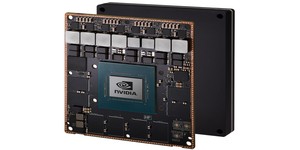Nvidia has announced the latest entry in its Tegra family of system-on-chip (SoC) processors, an eight-core 64-bit beast destined for the automotive market.
Nvidia has long been attempting to break into the CPU market, aiming at the mobile and embedded sectors with designs based on the ARM architecture from the eponymous Cambridge-based design house. Its most recent creation, the Tegra K1, has coupled up to four high-performance ARM cores to a 192-core Kepler-class graphics processing unit, offering massive compute performance in a very low power envelope - but its replacement goes even further.
Announced at the company's Consumer Electronics Show (CES) keynote, the Tegra X1 builds on the Tegra K1 but improves upon its predecessor in every way. The quad-core 32-bit and dual-core 64-bit variants have been replaced with a single 64-bit model featuring eight physical ARM general-purpose cores and 256 Maxwell-architecture graphics processing cores on a single chip. Interestingly, the company has opted to do away with its own 'companion core' layout of previous Tegra chips in favour of a design based on ARM's own big.LITTLE architecture: four of the CPU cores are high-performance Cortex-A57 models with 2MB of L2 cache, while the remaining four are lower-power Cortex-A53 parts with 512KB L2 cache.
The graphics portion of the chip promises much: as well as support for the mobile-centric OpenGL ES 3.1 common to most ARM-based SoCs, the Maxwell GPU hardware includes the ability to run full-fat DirectX 12 and OpenGL 4.4 as well as the company's own general-purpose GPU (GPGPU) offload language CUDA. Interestingly, however, support for OpenCL - CUDA's biggest competitor - is missing from the company's announcement, despite being a feature of the last-generation Tegra K1.
Nvidia's first Tegra X1-based products will not be smartphones or tablets: as part of the company's renewed focus on the automotive market, the company announced the Nvidia Drive PX and CX computers. The latter is a 'cockpit computer,' designed to run everything from infotainment to navigation systems; the former an 'autopilot development platform' packing two Tegra X1 processors and support for up to 12 high-resolution cameras.
'Mobile supercomputing will be central to tomorrow's car,' claimed Nvidia president and co-founder Jen-Hsun Huang during the keynote speech. 'With vast arrays of cameras and displays, cars of the future will see and increasingly understand their surroundings. Whether finding their way back to you from a parking spot or using situational awareness to keep out of harm's way, future cars will do many amazing, seemingly intelligent things. Advances in computer vision, deep learning and graphics have finally put this dream within reach.'
Firm pricing and availability for products based around the new Tegra X1 SoC have yet to be announced, with Drive PX and CX devices expected to appear on the market in the second quarter of 2015. More details are available from the official website.
Nvidia has long been attempting to break into the CPU market, aiming at the mobile and embedded sectors with designs based on the ARM architecture from the eponymous Cambridge-based design house. Its most recent creation, the Tegra K1, has coupled up to four high-performance ARM cores to a 192-core Kepler-class graphics processing unit, offering massive compute performance in a very low power envelope - but its replacement goes even further.
Announced at the company's Consumer Electronics Show (CES) keynote, the Tegra X1 builds on the Tegra K1 but improves upon its predecessor in every way. The quad-core 32-bit and dual-core 64-bit variants have been replaced with a single 64-bit model featuring eight physical ARM general-purpose cores and 256 Maxwell-architecture graphics processing cores on a single chip. Interestingly, the company has opted to do away with its own 'companion core' layout of previous Tegra chips in favour of a design based on ARM's own big.LITTLE architecture: four of the CPU cores are high-performance Cortex-A57 models with 2MB of L2 cache, while the remaining four are lower-power Cortex-A53 parts with 512KB L2 cache.
The graphics portion of the chip promises much: as well as support for the mobile-centric OpenGL ES 3.1 common to most ARM-based SoCs, the Maxwell GPU hardware includes the ability to run full-fat DirectX 12 and OpenGL 4.4 as well as the company's own general-purpose GPU (GPGPU) offload language CUDA. Interestingly, however, support for OpenCL - CUDA's biggest competitor - is missing from the company's announcement, despite being a feature of the last-generation Tegra K1.
Nvidia's first Tegra X1-based products will not be smartphones or tablets: as part of the company's renewed focus on the automotive market, the company announced the Nvidia Drive PX and CX computers. The latter is a 'cockpit computer,' designed to run everything from infotainment to navigation systems; the former an 'autopilot development platform' packing two Tegra X1 processors and support for up to 12 high-resolution cameras.
'Mobile supercomputing will be central to tomorrow's car,' claimed Nvidia president and co-founder Jen-Hsun Huang during the keynote speech. 'With vast arrays of cameras and displays, cars of the future will see and increasingly understand their surroundings. Whether finding their way back to you from a parking spot or using situational awareness to keep out of harm's way, future cars will do many amazing, seemingly intelligent things. Advances in computer vision, deep learning and graphics have finally put this dream within reach.'
Firm pricing and availability for products based around the new Tegra X1 SoC have yet to be announced, with Drive PX and CX devices expected to appear on the market in the second quarter of 2015. More details are available from the official website.

MSI MPG Velox 100R Chassis Review
October 14 2021 | 15:04









Want to comment? Please log in.